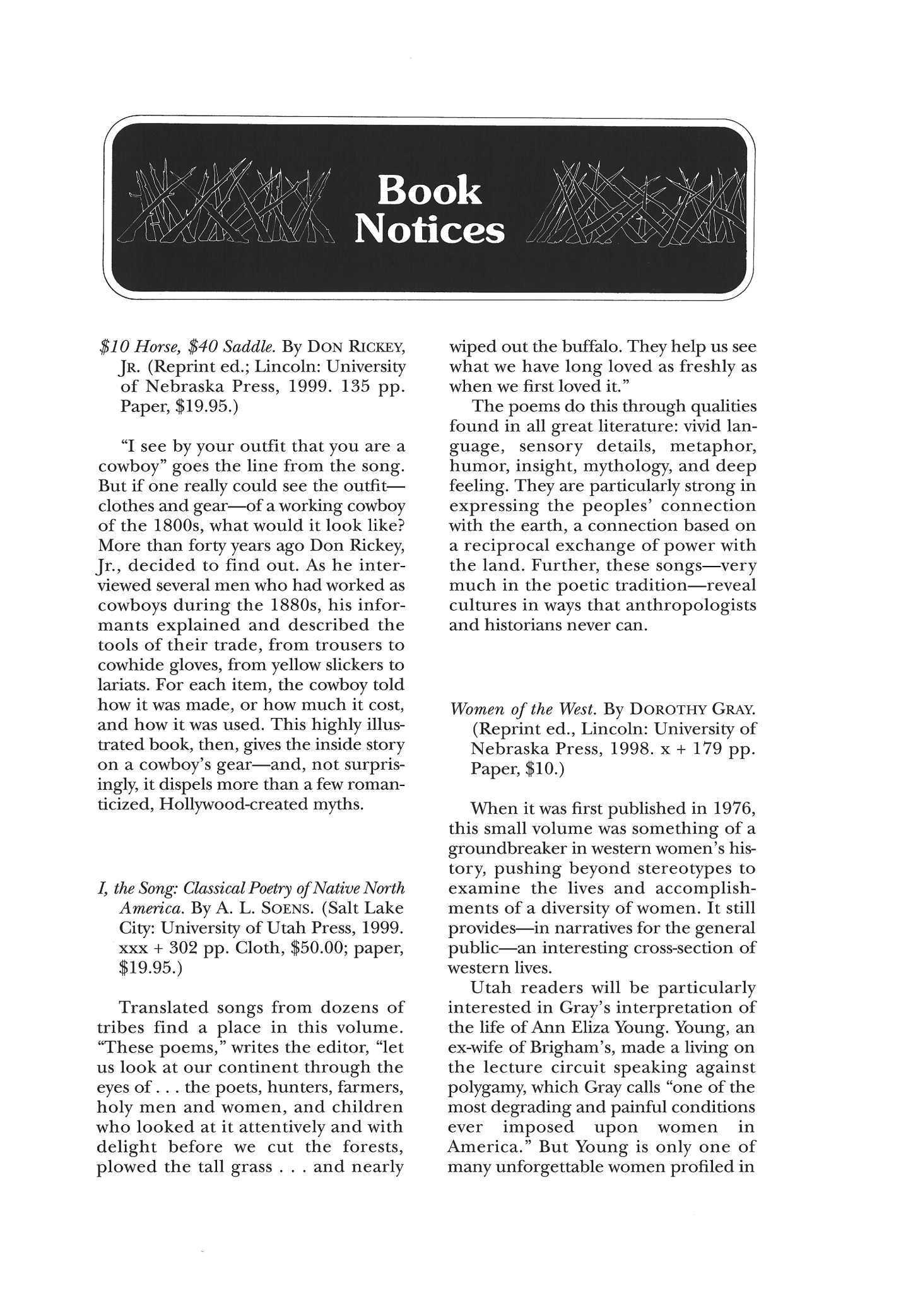
4 minute read
Book Notices
$10 Horse, $40 Saddle.
By DON RICKEY, JR (Reprint ed.; Lincoln: University of Nebraska Press, 1999 135 pp Paper, $19.95.)
"I see by your outfit that you are a cowboy" goes the line from the song. But if one really could seethe outfit— clothes and gear—of a working cowboy of the 1800s, what would it look like? More than forty years ago Don Rickey, Jr., decided to find out As he interviewed several men who had worked as cowboys during the 1880s, his informants explained and described the tools of their trade, from trousers to cowhide gloves, from yellow slickers to lariats. For each item, the cowboy told how it was made, or how much it cost, and how it was used This highly illustrated book, then, gives the inside story on a cowboy's gear—and, not surprisingly, it dispels more than a few romanticized, Hollywood-created myths.
I, the Song: Classical Poetry of Native North America.
By A. L. SOENS (Salt Lake City: University of Utah Press, 1999. xxx + 302pp. Cloth, $50.00; paper, $19.95.)
Translated songs from dozens of tribes find a place in this volume "These poems," writes the editor, "let us look at our continent through the eyes of. . .thepoets, hunters, farmers, holy men and women, and children who looked at it attentively and with delight before we cut the forests, plowed the tall grass and nearly wiped outthebuffalo. They help us see what we have long loved as freshly as when we first loved it."
The poems do this through qualities found in all great literature: vivid language, sensory details, metaphor, humor, insight, mythology, and deep feeling. They are particularly strong in expressing the peoples' connection with the earth, a connection based on a reciprocal exchange of power with the land. Further, these songs—very much in the poetic tradition—reveal cultures in ways that anthropologists and historians never can.
Women of the West.
By DOROTHY GRAY (Reprint ed.,Lincoln: University of Nebraska Press, 1998 x + 179pp Paper,$10.)
When itwas first published in 1976, this small volume wassomething of a groundbreaker inwestern women's history, pushing beyond stereotypes to examine the lives and accomplishments of a diversity of women. It still provides—in narratives for the general public—an interesting cross-section of western lives.
Utah readers will be particularly interested in Gray's interpretation of the life ofAnn Eliza Young Young, an ex-wife of Brigham's, made a living on the lecture circuit speaking against polygamy, which Gray calls "oneofthe most degrading andpainful conditions ever imposed upon women in America." But Young is only one of many unforgettable women profiled in these pages Sacajawea and Willa Cather find a place here, as do the nameless Chinese girl-slaves forced to work as prostitutes and the woman who rescued hundreds of these girls. Others include ranchers, professionals, suffragists, missionaries, and heroines of the trail
The Invasion of Indian Country in the Twentieth Century: American Capitalism and Tribal Natural Resources.
By DONALD L FIXICO (Niwot: University Press of Colorado, 1998 xxii + 258 pp Cloth, $39.95; paper, $22.50.)
Angry at times—and justifiably so— this book tells the second part of the Anglo/Indian story the part that came after the tribes were shunted to reser- vations As corporations and individuals have recognized the resources that lay on or beneath many of the reservation lands, the tribes have had to deal with almost-overwhelming forces of greed. Energy resources, gold, water, hunting and fishing rights, and timber are all areas where outside entities have maneuvered profits from Indian-owned resources The results have harmed individuals, social structures, cultural traditions, and the land.
Beyond its documentation of the clashes between tribes and outsiders hungry for wealth, the book makes a conscious and scathing statement against "capitalist greed." The author concludes his study by noting, "The human race is destroying itself via its industrial technology and capitalistic attitude—all of which depends upon the earth's natural resources." (215)

